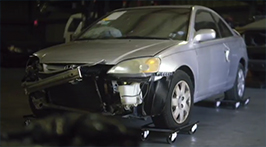Gas stoves and grills are powered by natural gas, propane, butane, liquefied petroleum gas or other flammable gas that is ignited either by a pilot flame or electric ignition. Gas stoves are common in interior kitchens, whereas gas grills are for outdoor use only.
According to recent statistics, 75 percent of American households contain a grill. Less than half of single-person households own a grill, but over 85 percent of family households do. The northeastern U.S. is shown to use outdoor gas grilling appliances more frequently than other areas of the country, even during cold winter months.
Gas-Cooking Device Defects
The most common injurious and fatal hazards associated with defective gas cooking devices include:
- Gas leaks
- Clothing ignition
- Flash and flame burns
- Hot surface burns
- Explosions
Manufacturing and design defects contribute to the risks associated with the use of gas-powered cooking devices. Some examples of such defects include:
- In 2002, 7,200 high-end gas ranges were recalled due to a high risk of the entire oven and range unit tipping over.
- In 2008, 4,800 gas outdoor grills were recalled due to cook box cracking that could be caused by grease fires. The primary hazards were those of burns and home fires.
Statistics
From 1999 to 2003, the us of gas ovens and stoves caused 75,200 home fires, resulting in 350 deaths, 2,790 injuries and $226.1 million in property damage. Other in-home gas cooking devices resulted in 10,500 home fires, 60 deaths, 420 injuries and $153.4 million in property damage. Gas grills and gas-operated outdoor cooking equipment ignited 3,200 home fires and caused 10 deaths, 140 injuries and $73.5 million in property damage.
In 2002, nine hundred emergency room visits were conducted and 1,940 injuries treated by American physicians as a direct result of gas cooking device usage. Approximately five percent of those resulted in hospitalization and 26 instances resulted in death.
As of 2001, 0.3 percent of all U.S. homes do not contain at least one standard oven. Of the 99.7 percent of American homes with standard ovens, 38 percent of them contain models that are gas-powered.
Gas-Cooking Device Recalls
According to the Consumer Product Safety Commission, product recalls were issued in the following instances due to defective or hazardous gas cooking appliances that resulted in injury, death and property damage:
- In 2006, Robertshaw Controls, Inc. recalled switches used in 7,800 gas cooking appliances and grills that caused gas to continue flowing after the pilot light was no longer ignited. The risk was that of the continued gas flow reaching a burner, igniting and/or exploding. Gas leakages resulting from this defect caused an ignition incident which caused two injuries.
- Thirty-five incidents of oven overheating, property damage, and one fatality were reportedly caused by defects in Amana’s Modern Maid gas wall ovens in 1995.
- In 2008, Frigidaire Canada recalled 7,500 Kenmore wall ovens due to gas buildup within the oven cavity during use. Upon door opening, flash fires occurred, resulting in 16 reports of burns.
